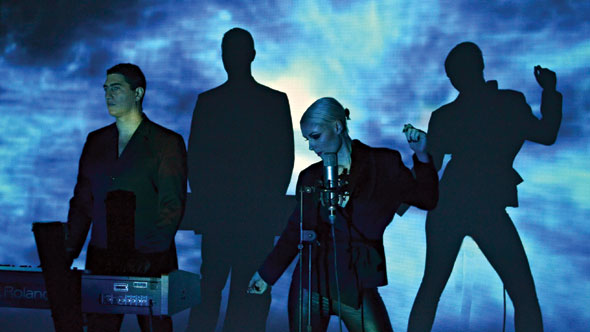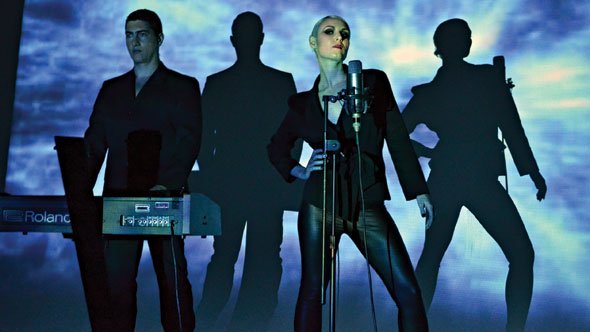
When the Australian duo known as Parralox put “I Fell in Love with a Drum Machine” up on their MySpace page in 2008, it went viral, causing a sensation in the international club community. The tune is slightly autobiographical, referencing the early life of the band’s songwriter and keyboard player, sci-fi enthusiast John von Ahlen. “In primary school, I had a pocket calculator, a Casio keyboard, and a drum machine,” von Ahlen recalls. “By the time I was 12, I was collecting drum machines and synthesizers. I loved machines with flashing lights.”
Parralox soon launched their own website, and succeeding songs—like “Hotter” and “I Sing the Body Electric”—added to the buzz. Each single was released in a digital package with eye-popping cover art designed to present a sleek, futuristic image to compliment the music. The combination of von Ahlen’s icy production style and the smoldering vocals of singer Amii Jackson brought to mind the golden age of 80’s synth-pop—a combination of playful decadence and sophistication. Although they haven’t made a large impact in Australia or America, Parralox has been playing festivals in England and Europe since they launched their campaign for world club domination. They released their first American single, “Sharper Than a Knife,” on iTunes in December and will follow it up with an album in early 2013.
Where does the name Parralox come from?
John von Ahlen: Coming up with a band name took a lot longer than writing the songs. I was watching Futurama one night and thought that a name with an X in it would sound futuristic. Parralox popped into my head. I thought it was an amazing inspiration. After we released our first song, a friend told me it was the name of an episode of AbFab—one of my favorite shows. The unconscious mind works in mysterious ways.
Parralox has a unique look to compliment its music—a combination of retro and futuristic styles. How important is good design?
JvA: People judge you on what you look like. It’s the simple truth. So we’re careful how we present ourselves. Music is a visual art form, so we aim for designs that are minimal and surrealistic. Factory Records (a British label from the 80’s) had an instantly identifiable sense of design—even their pets had catalogue numbers. So we use a template that allows you to instantly spot a Parralox single or album. In the 80’s, bands tried to show off their individuality: creatively, musically, and visually. Everyone had a look that set them apart. These days, it’s about having a new look every year. We want to strip it back to keep things simple, clean, and sophisticated.
You’ve released three albums and quite a few singles in Australia. Does songwriting come easy to you?
JvA: Everything inspires me. Another song, something I play on the keyboard, a phrase Amii sings to me. I often hear songs in my sleep and wake myself up so I can record them on my phone. The next morning, I get into the studios and create. I like science and watch a lot of documentaries. A black hole or a physics problem can inspire me. I wrote “Ancient Times” from the perspective of someone looking back on everything that ever happened in all of time and trying to make sense of it. Inspiration is just a matter of being alert to take an impulse or an idea and turn it into something you can sing. I often wonder where songs come from myself. Where do dreams come from? It’s all random patterns of atoms in our head that we can somehow make into something cohesive. Creativity is taking the random and making it real.

Parralox
When you mention formative musical experiences, you often reference Patti Page alongside Human League and Depeche Mode.
JvA: My parents listened to Patti Page and Rosemary Clooney. What stood out to me, as a boy, was her amazing voice. There was one LP they had with a photo of Patti in a green hoodie, looking like Rose from the X-Men. She reminded me of a superhero, and the songs were inspiring, even though they were from the 40’s and 50’s. I’m always drawn to interesting female vocalists like Billie Holiday, Ella Fitzgerald, and Patti. I still listen to her today—maybe not literally today, but within the last week.
The music you draw inspiration from—New Order, Pet Shop Boys, Madonna—all found success with gay audiences at first.
Do you think gay culture influenced the evolution of dance music?
JvA: Of course, and it’s not because straight people are deaf. Disco and electronica found a voice in the underground gay clubs, and what was once underground and gay slowly became part of the mainstream music culture. Without gay clubs, we’d be stuck in a bleak landscape of AC/DC cover bands. Without disco and drag queens, the world wouldn’t be worth living in.
Text by J. Poet